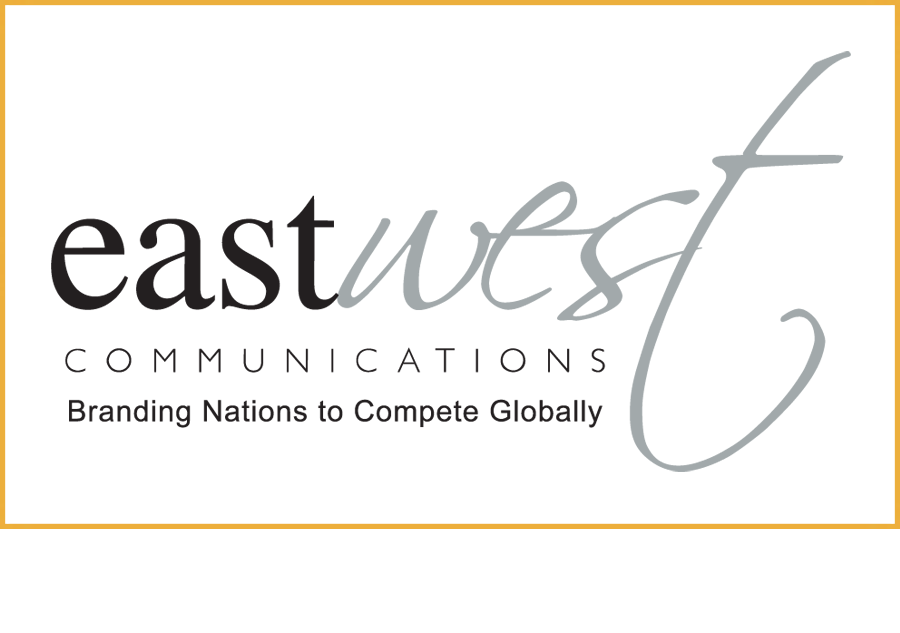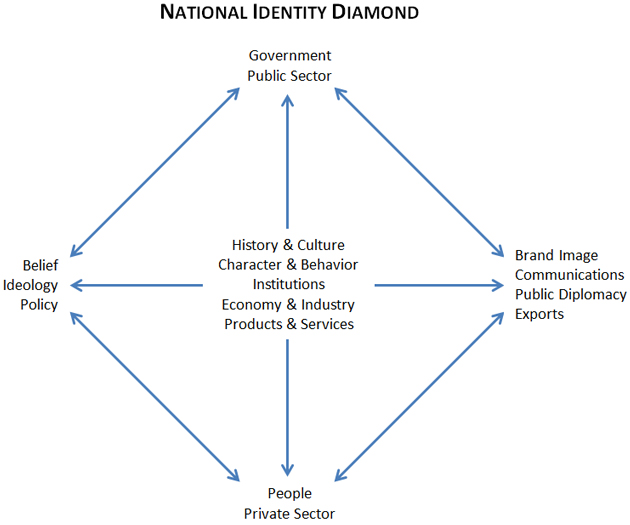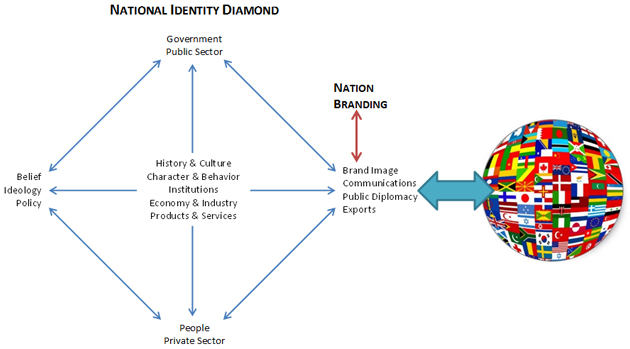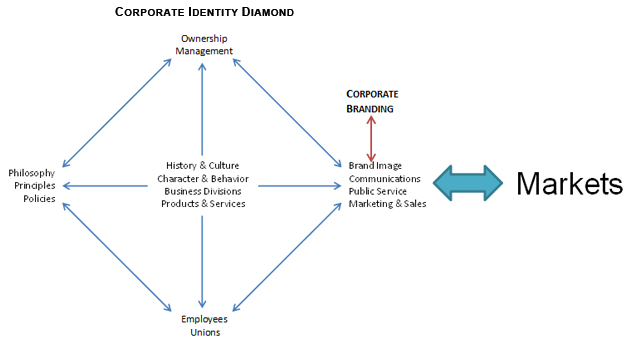
Resources

National Identity and National Image
A Purpose-Driven Approach to Nation Branding
By Thomas Cromwell
December 2, 2013
A fundamental assumption of nation branding is that there are positive elements in the national identity that are not well reflected in its image, and that the country’s brand can be shaped and managed to address such deficits. This article looks at what national identity is and how it is created, and then examines the various means by which that identity is, or can be, communicated. It concludes that the intrinsic complexity of countries imposes limits on the extent to which they can be effectively branded as you would brand a corporation, product or service. It argues that to be effective any nation branding exercise embody a strategic approach to improving the positioning of a country in the global system that recognizes those limitations. Branding strategies and methodologies will vary, as they should, given the diversity of nations in the world, but they should produce positive results for the country, its people and institutions. In a purpose-driven approach to nation branding, positive results are secured through starting with a clear delineation and articulation of the objectives and scope of the exercise, enabling meaningful assessment of the results.
For the sake of this discussion, I will not explore the role of location, size, nature, climate and other natural factors that contribute to national identity, since these are a given. That is not to say they are not important. A beautiful island in the Caribbean with lush vegetation, pristine sandy beaches and turquoise seas surrounding it enjoys a set of national assets that undoubtedly play an important role in its identity and image, and will be critical to any branding exercise. But our interest here is the people and man-made institutions on that island, and the role they play in shaping its identity and image.
Countries are complex because people and social groupings are complex. National identity is shaped by the beliefs and behavior of people and the institutions they create, which evolve over time and which are influenced by the beliefs and behaviors of other people and institutions. Beliefs and behaviors themselves are the result of the interplay of many forces. They are influenced by the collective experiences of societies interacting with nature, by racial, ethnic and religious forces, by leaders, governments and other institutions, and by technology.
I have organized these interactions into a National Identity Diamond which serves the purposes of this discussion (Diagram I). The NID recognizes that national identity is manifest in a country’s history and culture, in the national character and in the country’s behavior. National identity is reflected in the institutions created by the government and people, in their economy and industries that they create, and in the products and services produced by those industries.
The type of government and the nature of its relationship with the people in any given country changes over time, in turn transforming the type, function and orientation of national institutions. Good government, whether by a benevolent and wise tribal chief, prince or king, or a well-founded democracy, will have a constructive relationship with the people, fostering the development of good personal and national character and behavior, good institutions, and a well-balanced economy that produces products and services that meet the needs of the people.
In countries with a government that exploits and oppresses its people, based on ideologies that do not respect the value and rights of individuals, institutions will tend to embody the negative characteristics of the ruling ideology, individual rights will be circumscribed, national behavior towards other countries will tend to be duplicitous and aggressive, and the economy will reflect imbalances between rulers and ruled, with the output of products and services designed to meet the needs only of ruling elites and not the general population.

Diagram I
Copyright: Thomas Cromwell
The Primacy of Belief and Ideology
Which brings us to the central role of belief and ideology in shaping national policies and identity. Belief can be a core foundation for a ruling ideology and the policies it fosters, for the relationships between government and people, as well as for personal and national behavior. For example, Christian ideals, morality and ethics were very important to America’s founding fathers as they sought to create a republic that would protect the rights of citizens to practice faith without government interference and to pursue happiness under the protection of fair laws. These beliefs (for some founders derived from Deism) informed the writing of the Declaration of Independence and the Constitution of the United States. This latter document sought to limit the power of government (especially national government) over the individual and, just to make its intentions clear, was almost immediately amended to include a Bill of Rights for citizens.
An even more prominent role for religion can be found in theocracies which seek to make government a direct instrument for the actualization of religious beliefs. In countries with a single dominant faith, this can be a powerful means to achieving popular support for government ideology and policies. Thus in a ‘Muslim country’ such as Saudi Arabia the government articulates many of its positions on domestic and foreign issues in terms of Islam. And Saudi institutions, from government ministries and agencies to schools and universities, are steeped in an Islamic worldview and Muslim beliefs.
I am using ideology to mean the translation of beliefs into concepts and systems of government, the desired relationship between government and the people, between the public and private sectors, and between the nation and the rest of the world. In this sense, ideology is paramount in shaping national identity and how national identity is projected to the rest of the world.
In addition to the examples of the United States and Saudi Arabia already offered, consider the role of communist ideology, based on a set of atheistic beliefs rooted in dialectical materialism, in shaping the Soviet Union and its European satellites, as well as countries as diverse as Albania, the People’s Republic of China, Cuba and South Yemen. In the Soviet Union, ideology trumped all other forces shaping national identity, from the injection of Marxist-Leninist ideas into education and the revision of history to the building of an aggressive military posture in the name of ‘world peace’ for ‘the people’. Soviet policies gave the Communist State almost unlimited power over the individual and family. They forced Kulaks to collectivize at the cost of millions of lives and skewed industrial priorities in favor of military over consumer needs. They justified Soviet occupation of central and east European countries, and the active support of ‘wars of liberation’ throughout the world. The cost in human lives and suffering has been unprecedented. Countries that languished under Soviet rule had uniformly dour brands reflected in unsmiling citizens, poor infrastructure, ugly new buildings and crappy consumer goods.
Consider, too, Nazi Germany. Hitler’s belief in the supremacy of the Aryan race infected all his thinking, from his ideas about human beings to the role of the state in a system of National Socialism. Nazi ideology transformed Germany, coloring everything German from the way the people thought about themselves to school curricula. It produced the systematic extermination of the Jewish people, gypsies and other minorities, and justified the militarization of a state with a thirst for global conquest. Foreign policy consisted of deception and aggression, the military invasion and occupation of two dozen countries and tens of millions killed. The Nazis adopted their own symbols, songs and weltanschauung to strengthen the remaking of Germany in their image. In Mein Kampf, Hitler describes the effort he put into perfecting the Nazi flag: “I myself, meanwhile, after innumerable attempts, had laid down a final form; a flag with a red background, a white disk, and a black swastika in the middle. After long trials I also found a definite proportion between the size of the flag and the size of the white disk, as well as the shape and thickness of the swastika.” This transformation of Germany’s identity and image was a terrifyingly successful rebranding exercise.
The examples above are used to provide stark illustrations of what is a universal phenomenon. The leading ideologies of nations and the beliefs that underpin them are always important in shaping their policies, identity and image. In the 21st Century the role of ideology may be less apparent because most countries pursue market-oriented economic policies, but the apparent triumph of free market economic systems in countries as varied as the United States, China, Saudi Arabia and Russia tends to disguise important ideological differences. These differences are usually manifested in the level of state involvement in the economy (through regulation, control or outright ownership of property and other assets), as well as through state control over mass media, the treatment of minorities and private citizens in general, and foreign policy agendas.
The heavy influence of ideology on policy, identity and image in the radical examples we touched on (Communism and Nazism) is underscored by the peoples’ rush to seek a new identity and image when the existing regime is defeated or collapses. Perhaps no better examples of rapid transformation in national policy, identity and image after the collapse of a radical ideology and the systems it spawned are to be found than in the post-Soviet world. No sooner had the Soviet Union lost its ability to maintain Communist rule of its constituent states and satellites in eastern and central Europe, than those states eagerly broke with the Communist/Socialist/Statist models of centralized government and economy to pursue democratic government and free markets. Indeed there was a race to leave the Russian sphere of influence, with its lurking legacy of socialist imperialism, and enter the Western European political and economic sphere through membership in the European Union, secured militarily through membership in the NATO military alliance. Countries from Estonia and Kazakhstan to Poland and the Czech Republic implemented radical political and economic reforms. The degree to which they could break with their immediate ideological past had a considerable impact on the speed of the transformation of their identity and image or, especially in the case of Soviet states that barely had an identity of their own within the USSR, in the creation of a whole new national identity and image. By reaching back in time to their pre-Soviet culture and history, and reaching forward to catch up with Western states, country after country reshaped its identity and image. Everything from the behavior of the people to the quality of construction and consumer goods was transformed at a rapid rate, in the process radically transforming the national identity and brand image.
But more subtle changes in ideology and policy than these examples take place all the time, in countries everywhere, having important influences over national identity and image. Consider the United States under President Barack Obama. He entered office with the “fundamental transformation” of the United States on his agenda. In the name of spreading the wealth more fairly he has increased government spending and regulation, and sought to give government a larger role in people’s lives, especially through the Affordable Care Act, which greatly expands government involvement in healthcare. In foreign policy he sought to “reset” relations with Russia and to show greater understanding and sympathy towards the Muslim world. He abandoned the “War on Terror” language of the George W. Bush administration, instead describing America’s military role abroad as “Overseas Contingency Operations.” He has sought to channel US foreign policy through international organizations, especially the United Nations, downplaying Washington’s own interests. Obama’s left-of-center domestic and foreign policies have had a considerable impact on America itself and on how it is viewed by the rest of the world.
The National Identity Interface with the World
In today’s world of sophisticated technologies that connect individuals, institutions and governments across international boundaries as never before, the formation of perceptions of a country by others is a complex process, making the management of a country’s image a difficult task. To help focus the thinking behind nation branding efforts, I have divided the interface of countries with the rest of the world into four areas, or channels, through which national identity is communicated (Diagram II).
Brand Image is the cumulative image of a nation in the mind of a person. Because of the diversity in national identity drivers and the way that individuals filter and integrate perceptions in their own minds, there is no single, monolithic brand image for a country.
Communications is a combination of privately- and publicly- produced information, news, advertising and public relations.
Public Diplomacy is designed to supplement traditional government-to-government diplomacy with, primarily, government-to-people communications and charitable efforts (in other countries) aimed at communicating national values and priorities to international audiences. This is a growing public sector activity (albeit paralleled by private sector non-profit activities), especially for sizeable economies that can afford the necessary expenditures.
Exports of a nation’s corporate output of products and services, generally driven by private sector activity, contribute to international perceptions of that country. Compare, for example, the image of Yugoslavia communicated by the export of Yugos to the image of Germany communicated by the export of Mercedes, BMWs, VWs and Audis. In addition to opportunities for trade, under exports I am including opportunities for investment and tourism, which governments have long promoted.
The Role of Nation Branding
Branding was developed in the corporate world to enhance the value of goods and services sold by a corporation, as well as the overall value of the corporation itself. Nation branding seeks to apply lessons from corporate experience to countries. It aims to provide a strategy and road map for proactive management of a nation’s image, communications, public diplomacy and export promotion to improve the country’s position in the world.
Nation branding is a discipline that facilitates the management of how a country’s image is shaped and communicated to the rest of the world, as well as to the country’s constituents and stakeholders, from individuals to institutions, corporations and government bodies.

Diagram II
Copyright: Thomas Cromwell
Lessons from Corporate Branding
It is in the arena of economic and business development that nation branding has the most to learn from its corporate cousin. A country’s market-related policies, its exports and opportunities for investment and tourism can be positioned, packaged, labeled and promoted for consumption in the world of shared economic values.
Branding itself is a fairly recent addition to the arsenal of tools developed to promote corporations, their product and services. Branding has grown out of the recognition that a financial value is associated with market perceptions of corporations and what they offer. Brands deliver an intangible but real value that can be estimated in dollars.
Corporate branding aims to capture, promote and enhance the value of the corporate identity in the marketplace, adding value to the corporation’s goods and services. Thus corporate branding strategies offer some approaches and techniques that are of value to the nation branding endeavor that seeks to elevate the ‘value’ of a country in the world system.
This can be demonstrated if we substitute a corporation for a nation in our National Identity Diamond, as we have in Diagrams III and IV. The Corporate Identity Diamond is limited to business entities and thus much less complex than its national counterpart. The limited complexity of companies compared with countries goes a long way towards explaining why corporate branding has proved a successful strategy for gaining market share and revenues, the undisputed object of businesses, while the benefit of nation branding to countries is still vigorously debated.
Not only is corporate identity more sharply defined, corporate management is better able to exert strong and effective influence, if not outright control, over all the elements associated with the business, including its branding and promotion. Governments generally are not able to exert equivalent control or influence over the many and varied elements that shape national identity and image.
In the corporate world, the brand is king, and must be supported and protected at all costs. Communications (including advertising and public relations), marketing and sales all take their cue from the brand and are designed to strengthen and promote the brand. Public service (such as sponsorship of charities) is undertaken to cast a halo over the corporate brand, in some cases as shared values initiatives in which the charitable activity is closely aligned with the commercial activities of the company (for example, a computer maker develops a low-cost laptop which can be donated to schools in impoverished areas). The shared values approach facilitates brand halo strategies for public service.

Diagram III
Copyright: Thomas Cromwell

Diagram IV
Copyright: Thomas Cromwell
The Limits of Corporate Comparisons
Most nation branding practice in recent years has developed around a conceptualization of the nation as primarily an economic animal. Some of the chief practitioners sell consultancy services to governments under the assumption that these countries can be branded to improve their international reputation, increase inbound investment as well as exports and tourism.
This type of consultancy tends to offer a four-step nation branding service: research of the brand as it exists, including strengths and weaknesses; education of national stakeholders in the value and process of nation branding; distillation of the brand essence into an attractive visual identity (logo) and catchy slogan (tag line); and promotion of that brand to target markets.
However, because countries are very different from corporations, nation branding can only be effective if corporate branding strategies are applied to nations in ways that fully recognize the differences between the two types of entities. Countries are made up of diverse forces, interests and elements interacting with one another and the rest of the world. Corporations exist to make profits for their owners by producing and selling products and services desired by the marketplace. Countries are generally run by politicians who have both personal and public agendas focused on keeping them in power. They are typically changed from time to time by voting cycles or other means, and with these changes come adjustments, or outright reversals, in national priorities and policies. Corporations have strong, centralized management that can decide key branding issues, and impose its decisions on all departments of the corporation.
Purpose-Driven Nation Branding
Because of the differences between countries and companies, any nation branding efforts must be preceded with a process of decision-making regarding the purpose of the nation branding. This may sound obvious, but the poor results of most nation branding projects to date are a consequence, at least in part, of a failure to delineate and articulate well the limited objectives at the outset.
This is also a matter of pragmatic humility on the part of those working on nation brands. No brand can fully encapsulate the identity of a nation, and it is rather foolish to assume or pretend otherwise. What nation branding can do is identify clear objectives that are meaningful within the scope of the exercise, and proceed to design a program that can deliver beneficial (and where possible measurable) results against those objectives.
As we have discussed here, nation branding should consciously include recognition of the impact of ideology and policy on national identity and image. Indeed, the nation branding process itself can serve as a cart of national objectives that pushes the horse of national identity and image to move along in positive directions. In other words, looking at a country from the point of view of how it can best be positioned in the world system can be an exercise that helps inform policy formation. So long as the rulers and ruling ideology are not averse to, or outright opposed to, policies that benefit the brand, this will be a fruitful approach.
However, if national ideology stands in the way of policy formation that supports an attractive brand image, the branding process will be limited to developing and promoting what national assets do exist in support of the desired brand. For some countries (think dictatorships and radically ideological states), there might be little to work with, but every nation has some things worth using as pillars of the nation’s brand.
Purpose driven nation branding is all about working with available national assets to shape the most attractive brand possible in service of achieving national objectives. At the same time, the nation branding process can help identify policy deficiencies and encourage positive change, change that can ultimately influence national ideology itself.

Attractive and Effective Nation Brands
In general, good nation brands should:
- Be true to the national identity
- Embody the best of the national identity
- Be different from the brands of other countries
- Be memorable
- Be attractive to target audiences
- Enhance the country’s position in the world
These general purposes should frame more specific objectives, such as:
- Increase exports, inbound investment and/or tourism
- Improve international reputation and clout
- Address misconceptions about the country
- Supplement narrow perceptions of the country
- Facilitate repositioning of the country
The art of nation branding (and for the moment it is more of an art than a science) is, then, to distill from a country’s national identity those assets, whether natural or man-made, that best support the purpose and objectives for which the nation branding effort is being undertaken. The ‘nation brand’ should then serve as a north star that guides the creation and management of initiatives within the four areas of interface with the rest of the world, described above.